Events & Promotions
|
|

GMAT Club Daily Prep
Thank you for using the timer - this advanced tool can estimate your performance and suggest more practice questions. We have subscribed you to Daily Prep Questions via email.
Customized
for You
Track
Your Progress
Practice
Pays
Not interested in getting valuable practice questions and articles delivered to your email? No problem, unsubscribe here.
- Nov 20
07:30 AM PST
-08:30 AM PST
Learn what truly sets the UC Riverside MBA apart and how it helps in your professional growth - Nov 22
11:00 AM IST
-01:00 PM IST
Do RC/MSR passages scare you? e-GMAT is conducting a masterclass to help you learn – Learn effective reading strategies Tackle difficult RC & MSR with confidence Excel in timed test environment - Nov 23
11:00 AM IST
-01:00 PM IST
Attend this free GMAT Algebra Webinar and learn how to master the most challenging Inequalities and Absolute Value problems with ease. - Nov 25
10:00 AM EST
-11:00 AM EST
Prefer video-based learning? The Target Test Prep OnDemand course is a one-of-a-kind video masterclass featuring 400 hours of lecture-style teaching by Scott Woodbury-Stewart, founder of Target Test Prep and one of the most accomplished GMAT instructors.
Originally posted by imhimanshu on 13 Jul 2012, 07:57.
Last edited by Bunuel on 05 Jun 2021, 06:45, edited 6 times in total.
Last edited by Bunuel on 05 Jun 2021, 06:45, edited 6 times in total.
Renamed the topic and edited the question.
Kudos
Bookmarks
C
Be sure to select an answer first to save it in the Error Log before revealing the correct answer (OA)!
Difficulty:
 15%
(low)
15%
(low)
Question Stats:
75% (01:12) correct 25%
(01:20)
wrong
25%
(01:20)
wrong  based on 14109
sessions
based on 14109
sessions
History
Date
Time
Result
Not Attempted Yet
Ryunosuke Akutagawa‘s knowledge of the literatures of Europe, China, and that of Japan were instrumental in his development as a writer, informing his literary style as much as the content of his fiction.
(A) that of Japan were instrumental in his development as a writer, informing his literary style as much as
(B) that of Japan was instrumental in his development as a writer, and it informed his literary style as well as
(C) Japan was instrumental in his development as a writer, informing both his literary style and
(D) Japan was instrumental in his development as a writer, as it informed his literary style as much as
(E) Japan were instrumental in his development as a writer, informing both his literary style in addition to
SC01946
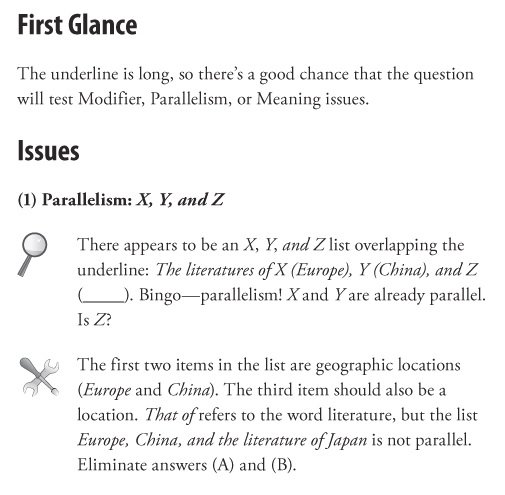
20.jpg [ 64 KiB | Viewed 103109 times ]
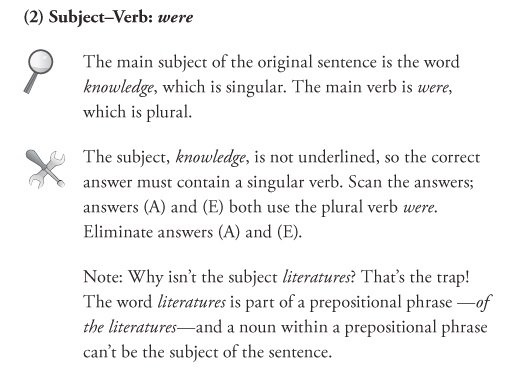
21.jpg [ 59.22 KiB | Viewed 103010 times ]
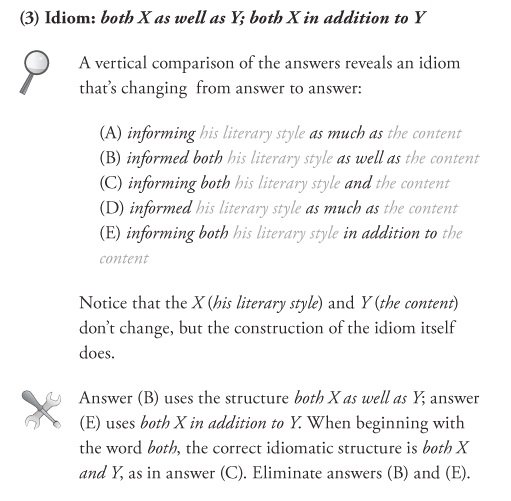
22.jpg [ 75.41 KiB | Viewed 102984 times ]
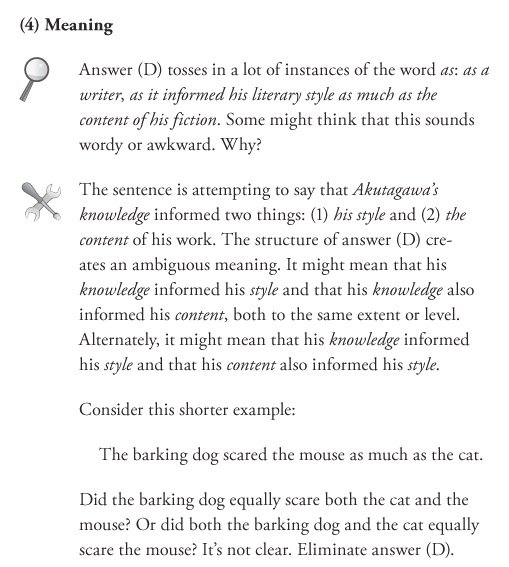
23.jpg [ 91.91 KiB | Viewed 103041 times ]
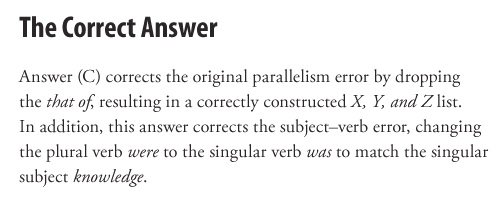
24.jpg [ 33.55 KiB | Viewed 102992 times ]
(A) that of Japan were instrumental in his development as a writer, informing his literary style as much as
(B) that of Japan was instrumental in his development as a writer, and it informed his literary style as well as
(C) Japan was instrumental in his development as a writer, informing both his literary style and
(D) Japan was instrumental in his development as a writer, as it informed his literary style as much as
(E) Japan were instrumental in his development as a writer, informing both his literary style in addition to
SC01946
Attachment:
20.jpg [ 64 KiB | Viewed 103109 times ]
Attachment:
21.jpg [ 59.22 KiB | Viewed 103010 times ]
Attachment:
22.jpg [ 75.41 KiB | Viewed 102984 times ]
Attachment:
23.jpg [ 91.91 KiB | Viewed 103041 times ]
Attachment:
24.jpg [ 33.55 KiB | Viewed 102992 times ]
Kudos
Bookmarks
Choice D’s problems stem from the pronoun ‘it’ and the conjunction ‘as’.
First, it can refer to either knowledge or development. In both cases, it does not fit in logically.
Second, the knowledge was the first factor, his development as a writer is the next factor, and the third is the information about his style and function. The development and the information thereof are independent functions and not cause and effects. D is distorting the meaning by implying that development and information occurred simultaneously or the information occurred because of development. ‘As’ has meaning of ‘because ’ and ‘at the same time’. This is fatal error.
First, it can refer to either knowledge or development. In both cases, it does not fit in logically.
Second, the knowledge was the first factor, his development as a writer is the next factor, and the third is the information about his style and function. The development and the information thereof are independent functions and not cause and effects. D is distorting the meaning by implying that development and information occurred simultaneously or the information occurred because of development. ‘As’ has meaning of ‘because ’ and ‘at the same time’. This is fatal error.
Kudos
Bookmarks
magicmanisha
Let us start with a simple sentence and see how it is ambiguous:
Second world war influenced scientific advancement as much as quest for knowledge.
This can be interpreted in two ways:
Second world war influenced scientific advancement as much as (Second world war influenced) quest for knowledge. In other words, second world war influenced:
a. scientific advancement and
b. quest for knowledge.
However, another way of interpreting this is:
Second world war influenced scientific advancement as much as quest for knowledge (influenced scientific advancement). In other words, scientific advancement was influenced by:
a. Second world war
b. quest for knowledge
Now, coming to this sentence, Ryunosuke Akutagawa’s knowledge informed the following two things:
1. Literary style
2. Content of his fiction
With D, the sentence would be:
Ryunosuke Akutagawa‘s knowledge of the literatures of Europe, China and Japan was instrumental in his development as a writer, as it informed his literary style as much as the content of his fiction.
Now, here is the tricky thing. The above sentence can be interpreted as:
Ryunosuke Akutagawa‘s knowledge of the literatures of Europe, China and Japan was instrumental in his development as a writer, as it informed his literary style as much as the content of his fiction (informed his literary style)
Which means Ryunosuke Akutagawa’s literary style was informed by the following:
1. Ryunosuke Akutagawa’s knowledge
2. Content of his fiction
So, there is an ambiguity of meaning, if D is the answer choice. Now, perhaps this ambiguity might be “tolerated” in some sentence in GMAT, if there is no better option; but here, C is definitely clearer.











